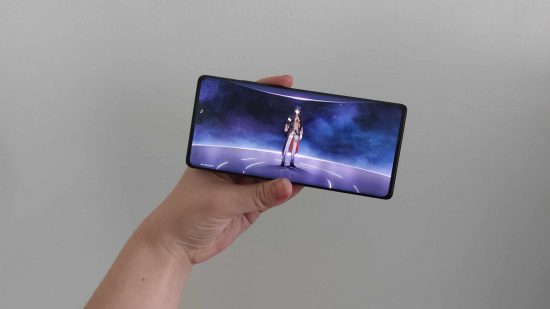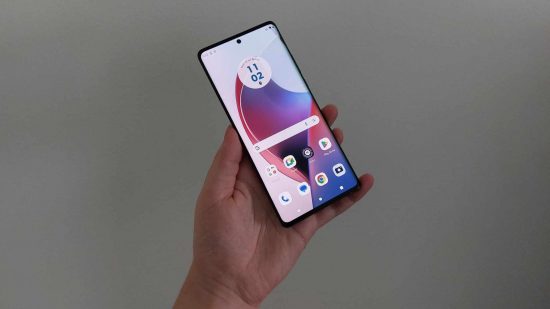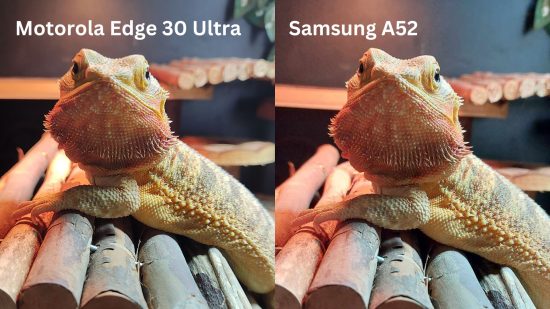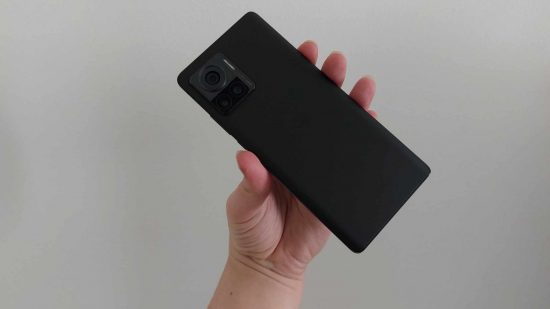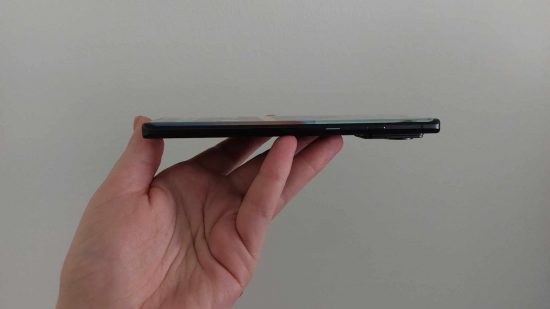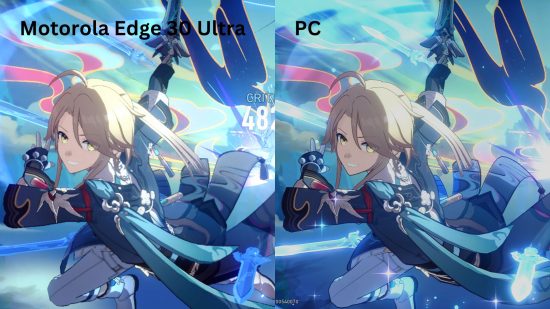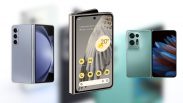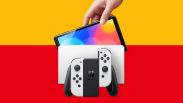Motorola may not be the most well-known smartphone brand out there nowadays, but the Motorola Edge 30 Ultra really feels like a comeback and offers a substantial piece of tech without a gigantic price tag.
The Edge 30 Ultra is a lot cheaper than options from Samsung and Apple, yet keeps up in terms of performance with the cameras, operating system, and choice of components, including a very competitive 144Hz screen and the Snapdragon 8+ Gen 1 chipset.
It’s also worth noting that I received a review copy that has been used, so it does also show where the phone is likely to show wear and tear – more on that in a bit. But first, let’s take a broad look at what the handset offers.
Pros:
- Clean and stylish design
- 144Hz OLED screen
Cons:
- Only IP52 rating
- Runs Android 12 (though it can be updated)
Price and availability
- Interstellar black – 12GB + 256GB memory ($) – £749/€899 RRP
The Edge 30 Ultra is currently out of stock on the Motorola site. It may come back into stock, but it may not. You can find listings on Amazon.
Specifications
| Battery | 4610mAh |
| Display | 6.67-inch 144Hz OLED (1080×2400) |
| CPU | Snapdragon 8+ Gen 1 |
| RAM | 8GB / 12GB |
| Storage | 128GB / 256GB / 512 GB |
| Cameras | Rear: 200 MP Front: 60 MP |
| Weight | 198g |
| Dimensions | 161.76 x 73.5 x 8.39 mm |
| Colors | Interstellar black |
Features
The Edge 30 Ultra comes with Android 12 as its operating system, but you can now upgrade it to Android 13. In fact, the phone won’t let you forget about it and has a constant notification until you update.
Motorola’s Gametime mode makes a reappearance on this model, too, making sure you can play games uninterrupted by other apps and notifications. Calls can also be blocked if you really want to focus. You can even integrate social media through the Gametime mode such as Discord and WhatsApp – this isn’t available in every game, though.
Adding to the gaming experience, the Edge 30 Ultra has an upgraded cooling system from past models and this shines through as it doesn’t get unbearably hot to the touch during long sessions, even if you have it flat on a surface.
Something that does seriously bring down my opinion of the Edge 30 Ultra is its consistent screen light-up. Seriously, any small movement makes the lock screen light up and it gets quite annoying quite quickly. I can only imagine how bad this would be in a pocket or bag, too.
Another downside is that like a lot of recent models, there is no SD card slot to add extra storage to this phone, but it does have 256 GB storage so it shouldn’t be a problem. The Edge 30 Ultra also has a disappointing IP rating, coming in at IP52, which means it ranks worse compared to most other brands’ flagship models.
Camera
I like to take photos on my phone, and obviously, better quality is preferred. The Motorola Edge 30 Ultra has a 200MP rear camera and a 60MP front camera, offering some very competitive specs. I currently use my Samsung A52 with no issues (64MP rear and 32MP front cameras), so I was excited to try out the Motorola.
Unfortunately, the camera on my Samsung A52 felt basically the same as that of the Motorola despite the high megapixel difference. There are more settings to play with on the Motorola, and it shows the white balance and other fun settings on the screen, but the picture quality afterward almost matched what I already had.
Now, megapixels aren’t everything, so let’s look at some real-life usage. I can’t recommend the Ultra’s camera for low light or nighttime photos as the results aren’t the best, but for daytime shots, it takes very pleasing captures. The macro mode is also quite impressive – especially in well-lit areas.
Sorry, no front-camera selfies here, but just know that I didn’t prefer it to my own phone again. The quality of the photos is good, but I didn’t find it to be very flattering, despite there being filter options, I didn’t notice much change in the gigantic dark circles under my eyes. There’s also the issue of trying to hold such a smooth and curved phone in a selfie-taking position – I don’t recommend trying without a case as it’s very slippery.
Design
The Motorola Edge 30 Ultra is a very sleek-looking phone at almost 6.7 inches tall and barely a centimeter thick. This is my first experience with a curved-edge phone, and while it looks nice and feels fancy, it didn’t take my breath away. The curve also means, as I mentioned before, that it’s hard to hold in certain positions and for a long time. The back glass is very smooth, too, which means the phone is rather slippery, and it isn’t easy to stand up against items without it sliding down.
As I mentioned, this is a review copy and already has some small scuffing to the camera casing. I would recommend a case for this as the camera is not flush with the back of the phone, so can easily catch on things and attract damage.
Display
This model boasts a stunning 144Hz OLED display – outside the realm of gaming phones this is quite rare, so it’s nice to see and experience as it makes everything perfectly smooth and fluid. The colors pop on the screen and the UI is clean and easy to navigate while being in a palatable color scheme.
The curved edge comes into play here. If you’re playing games with lots of menus or apps filled with icons, they can fall onto the curved edge of the screen and be harder to press. Despite this, the touch screen is incredibly responsive, down to the 300Hz touch-sampling rate boosting the accuracy and overall performance.
Battery life
I’m in two minds about the phone’s battery. The longevity of a full charge is really good, and even while using hefty apps, there’s no quick drain on it. For instance, after playing Honkai Star Rail for a full half an hour, the battery went from 64% to 57%. While updating the game initially, the battery drained roughly 2% every ~5 mins while downloading. In my experience, this is more than acceptable and can allow me to continue playing mobile games for long stretches of time. What likely does affect the battery, however, is how often the screen lights up at the slightest movement.
I wasn’t able to test out the phone’s fast-charging capabilities, but the phone boasts a 125W wired charging speed, which is mightily impressive. This means that any battery drain worries should be easy to solve just by plugging it into the mains. You can also charge it wirelessly at 50W, faster than much of the competition, and do 10W reverse wireless charging if you need to give a different device some juice. On paper, it’s an impressive battery experience.
Performance
The performance of the Motorola Edge 30 Ultra is really very good for its price. It comes with the Snapdragon 8+ Gen 1 processor, still one of the best chips on the market even though it’s a year old – coupled with the impressive 12GB RAM this makes the Edge a bit of a beast.
All videos, games, photos, and very dense webpages I tried and looked at load very fast and run seamlessly, even when multiple apps are open at the same time. But the real focus here is gaming, given that we’re a gaming site.
When using my trusty benchmarking tool, Honkai Star Rail, there were no real issues. The game was a little sticky on the initial loading screen, but once you’re in the game there are no hang-ups or issues. For context, here’s a comparison of the game’s performance on high settings with 30 FPS on the Edge 30 Ultra and on my PC.
Less intensive games like Merge Mansion and Disney Emoji Blitz work absolutely fine with no visual or frame issues, even online multiplayers performed surprisingly well. Pokémon Unite, for instance, runs brilliantly in on and offline modes, no matter how much is going on on the pitch.
Should you buy the Motorola Edge 30 Ultra?
If you’re not looking for the absolute latest and greatest (and most expensive) model, the Motorola Edge 30 Ultra is a good bet for you. It has fantastic overall performance with plenty of storage, long battery life, and good cameras, with a sleek design to top it off.
There aren’t really any negatives for me to point out here, other than its big brother the Motorola Edge 40 is now available, but at a higher price. At release, the Edge 30 Ultra came with Android 12 which was a drawback, but now can be upgraded so you can stay up to date.
If the Motorola Edge 30 Ultra isn’t for you
Not quite sold on the Motorola Edge? We’ve got a couple of other options for you to check out.
OnePlus 10 Pro
The OnePlus 10 Pro offers good competition in that it is the same size, and has the same chipset, RAM, and storage as the Edge 30 Ultra. It comes in different colors, which the Edge does not, and has cameras co-developed with Hasselblad including a 48MP primary camera. This is a little pricier, though, retailing for $869/£899.
Google Pixel 7
The Google Pixel 7 is another great option that won’t break the bank, as RRP starts from $699/£599 making it a bit cheaper than the Edge 30 Ultra. The Pixel 7 has the same storage options, and a nice green color option, but comes with a built-in VPN and uses the Google Tensor G2 chipset. Really, it boils down to how you want your phone to look, and what extras you prefer having.
Motorola Edge 30 Ultra
The Motorola Edge 30 Ultra meets all needs you could possibly have for a modern smartphone without being too bulky in the pocket, or hitting the wallet too hard.
